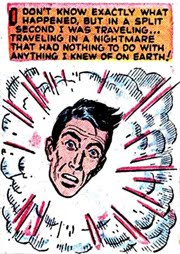Part Three




THE UNEXPECTED SUCCESS OF A POOR STUDENT
...
Dr. Hans Pulaski was a poor student; He failed Spanish four times and never learned the rules of basketball, yet because of his inadherence to the rules of science and possibility, he promptly changed the world as we know it.
Hans Pulaski’s father, Dietrich, was a baker. Mr. Pulaski made the best donuts in East Berlin, and he taught his son everything he knew. “Took about three weeks, then he went right over my head” said Mr. Pulaski to reporters after the 2024 World’s Science Fair that made his son famous. “He dropped out of high school after his mother died of pneumonia, and left for America. Took about four months, then he sent me a letter: “Dad, I need three thousand American dollars, and eight dozen glazed,” it said, so I took out a second mortgage on the shop and sent him five thousand dollars and three dozen glazed.” Chuckled Pulaski; “Seems now like he must have spent the money well, but I still knew that he couldn’t eat eight dozen donuts before they turned to bricks.” Mr. Pulaski later invented the “mini-donut hole” (later discredited as being merely crumbs) in honor of his son’s greatest creation.
Hans Pulaski’s private life after he left his father in East Berlin is mostly shrouded in mystery (as are all successful entrepreneurs,) leaving only anecdotal tales like this one from Hans’ half-sister, Maragette Pulaski, art curator and president of the Tiny Lives corporation (taken with permission from the cover story of “Je Ne Se Qua”, August 2025:) “….so I invited my brother to Paris to see the World’s Science Fair, of which I was the head organizer. I had always considered Hans utterly incapable of taking care of himself, and didn’t expect him to show up on my doorstep two days before the event, but he did, and he showed up with about what I expected: A sack full of precisely one change of socks, three pairs of underwear, and a dozen notebooks scribbled with notes. He also had a large crate full of the early prototypes of what he, at that time, was calling “cortex-extenders,” and promptly told me that he must be allowed to demonstrate his experiments at the Fair.”
“Now, one can’t just whip up extra space in an event as coordinated as the W.S.F., but I fronted the entry fee and wrangled him in beside a hack inventor with a penchant for breakfast footwear, who as I remember made a mint off his product solely because of his proximity to Hans’ booth.”
“I convinced Hans to re-brand his little people because I knew that 2024 was the year of the acronym, and as Hans trusted my ability to create a marketable property, we came up with NEURO-ELECTROWAVE MAN, or N.E.W.MAN, the night before the fair.”
The 2024 World’s Science Fair is famous for two things: The world’s first brain-wave controlled clone-android (known as an N.E.W.MAN,) and Waffle Shoes, the shoes that make waffles while you walk.
Pulaski’s design was ingenious in that it ultimately exercised and developed the ability for the human brain to exist outside of itself. Up to that point, the theory that brain waves could operate machines had been widely accepted as possible but not practical as the dorsal lateral pre-frontal cortex (the part of the human brain responsible for decisions and volition) shuts down when you sleep, causing any brain-wave controlled machine to act unpredictably. The advantage of the Newman design was that by using a clone enhanced with artificial motor skills, and having it require so little electrical motivation due to its size, it was extremely susceptible to mental suggestion by its native host (incorrectly referred to as “organic telepathy” in the original gimmicky hand booklet accompanying the early N.E.W.MAN, leading to an outbreak of late 22nd century soothsayers who thought that the newman technology had opened up their dormant “third eye.”)
Because the Newman was essentially an extension of the body, it was very predictable, sharing a brain (or, more accurately, “instinctually communicating” as muscles do) with its host. The process of learning to simultaneously operate both a human body and a symbiotic body was not incredibly difficult, but sometimes could be disconcerting as host often forgot which “body” they were in.
After the N.E.W.MAN swept the World’s fair, it was fast tracked to the public market and quickly made the burgeoning company HANSCO the most profitable company in the world with the famous “N.E.W.Christmas” campaign a year later that saw Pulaski’s technology introduced into one-third of America’s homes. The first (and most popular) subsidiary, Tiny Lives, was run by Maragette Pulaski as a fashion-oriented miniature clothing and accessory retailer. Hundreds of non-affiliated retailers eventually followed due to the overwhelming popularity of the invention, with the Newman now commonly considered to be an indispensable milestone in popular culture. The N.E.W.MAN has been voted the “Most Important” invention in every magazine short list for the last two hundred years, still beating out its unlikely pre-destined companion, the G.M.T.P.A. Waffle Shoes are not typically considered for these lists.
...
So there you go, that's all I had written on the subject. Here are some ads I made advertising the Newmen (later symbiots) as they might have occured in the alternate reality. Thank you for reading.










No comments:
Post a Comment